Stop overpaying - start transferring money with Ogvio. Sign up, invite friends & grab Rewards now! 🎁
Thinking about buying Litecoin? If so, you'll need to make sure to keep your Litecoin safe. Thus, in this guide, I'll help you find the best Litecoin wallet. We will explore various types of wallets, including hardware and software options, like Ledger Flex or Binance Wallet, and we'll even touch upon Litecoin paper wallet services, including why strong security for your crypto is so important.
By the end of this guide, you’ll be able to pick which one of these is the best Litecoin wallet for your own unique needs:
- Ledger Flex - E-Ink Touchsreen for Secure and Clear Transactions
- Trezor Safe 5 - Cold Storage with Tactile Feedback and Open-Source Trust
- Trezor Safe 3 - Budget-Friendly and Compact Cold Storage
- Ledger Stax - Luxury-Level Cold Storage for Your Assets
- Binance Web3 Wallet - A Smooth Blend of Self-Custody and Convenience
- Coinbase Wallet - Web3 Wallet for Storing, Swaping, and Exploring Litecoin
- Nexus Wallet - Everyday Mobile Wallet for Spending and Securing LTC
- Exodus - An All-Rounder Software Wallet With Hardware Wallet Integration
Besides, if you don't know what Litecoin is or how it works, we'll also take a look at that at the end of this article.
1. Ledger Flex - E-Ink Touchsreen for Secure and Clear Transactions
Ranks #1 out of 8 Crypto Wallets
- + User-friendly design
- + Robust security
- + Long battery life
- + Thousands of digital assets
- + Free Ledger Recovery Key included
- - No wireless charging
$90 BTC BONUS
Ledger Holiday Season Sale
Grab Ledger Stax, Flex and Nano S Plus during this Holiday Season & get BTC vouchers worth up to $90! 2025 is almost over and so is the stock for this deal, hurry up!
If you’ve been searching for a wallet that keeps your Litecoin secure without making things complicated, Ledger Flex is definitely worth a look. It’s the newest member of the Ledger family and combines rock-solid security with a sleek, easy-to-use design.
Flex is all about keeping your coins truly safe with "cold" storage, meaning your private keys stay offline. Add in PIN protection and encryption, and you’ve got a serious security setup. As a bonus, Ledger includes a Ledger Recovery Key in the box at no extra cost, giving you an extra backup option right out of the gate.
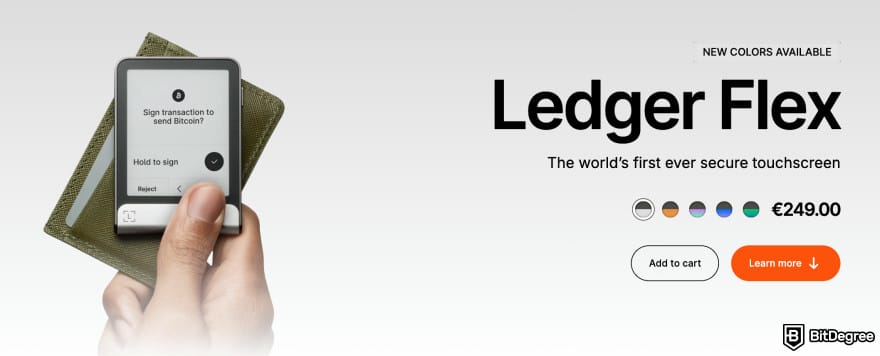
You’ll also notice the E-Ink touchscreen, which makes it easy to read and confirm every transaction before approving it with a tap. No second-guessing, no tiny buttons – just clear details you can trust.
Pair the Flex with the Ledger Live app, and you can buy, send, receive, and even swap Litecoin directly. And since Ledger Live works on Mac, Windows, and Linux, as well as Android and iPhone, you can manage your Litecoin on pretty much any device you have.
Key Features
Here are some of the main features that make Ledger Flex stand out:
- Cold Storage Security for Litecoin. Secured with an EAL6+ Secure Element chip, Flex keeps your LTC private keys entirely offline, meaning they never touch the internet.
- Full Litecoin Management in Ledger Live. You can handle your LTC directly in the app: buy from trusted providers, send and receive securely, and swap LTC for other supported cryptocurrencies.
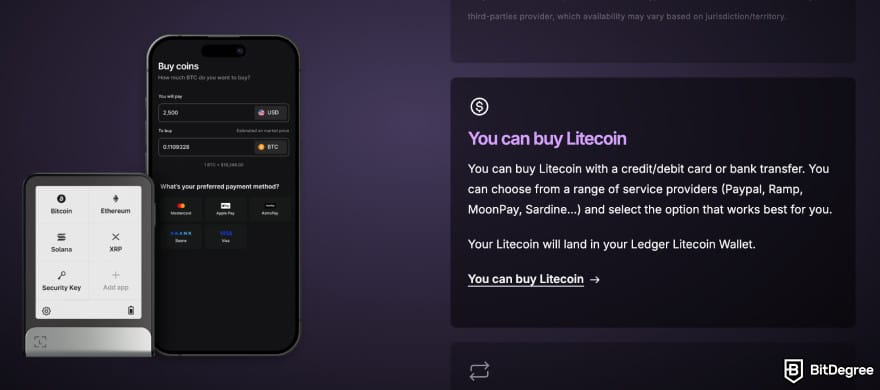
- PIN & Encryption Protection. Even if someone gets hold of your Ledger Flex, they can’t access your Litecoin without your PIN, and the built-in encryption keeps your data safe from tampering.
- Ledger Recovery Key Included. The wallet comes with an NFC-enabled recovery card at no extra cost. This lets you securely restore your Litecoin wallet if your Ledger Flex is lost, stolen, or damaged.
- E-Ink Touchscreen Confirmation. A crisp, easy-to-read display shows every detail of your Litecoin transactions before you approve them. This “what you see is what you sign” approach ensures you’re always sending the right amount to the right address.
The only downside is that it’s not the cheapest option, priced at $249 (especially when many software wallets are free), but the security and peace of mind you get is hard to put a price on.
2. Trezor Safe 5 - Cold Storage with Tactile Feedback and Open-Source Trust
Ranks #2 out of 8 Crypto Wallets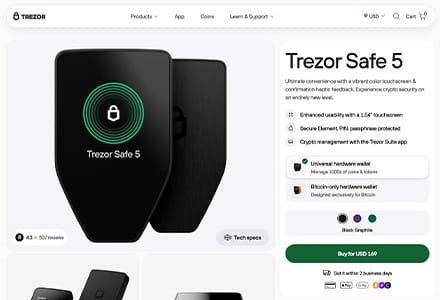
- + Supports 1,000+ crypto assets
- + Easy navigation
- + Open-source
- + EAL6+ certified chip
- + Enhanced security features
- - Quite expensive
- - No seed recovery service
EXTRA 10% OFF
With Trezor Promo Code "Special2"
Get an exclusive 10% discount on ANY Trezor product, including the newest Safe 7 wallet, with our promo code "Special2"! Works on top of other Trezor Holiday Sale discounts.
Trezor Safe 5 is one of the best Litecoin hardware wallets built to combine strong security with everyday usability. It’s equipped with an NDA-free EAL6+ certified Secure Element chip, giving it protection against both hardware and software attacks.
Add to that a sturdy Gorilla Glass color touchscreen with tactile haptic feedback, and you have a wallet that’s both durable and comfortable to use for managing your Litecoin.
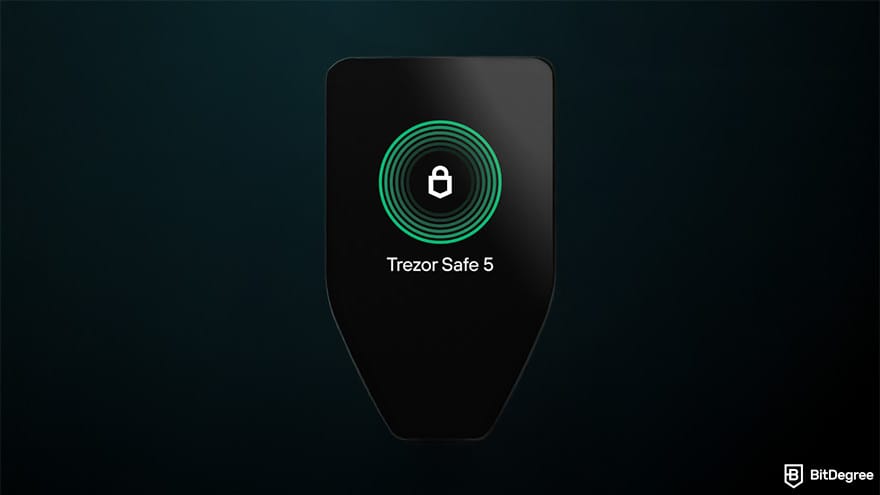
The wallet works seamlessly with the Trezor Suite app, allowing you to send, receive, buy, and swap Litecoin from your desktop, web browser, or mobile device. It’s compatible with macOS, Windows, Linux, and even Android and iOS for view-only portfolio tracking.
Plus, it has a built-in microSD card slot, which adds an extra layer of defense against physical breaches. Combined with cold storage, this makes it much harder for anyone to tamper with your device or extract your private keys. And like other Trezor models, the Safe 5 is open-source, so its security can be independently verified.
Key Features
The following are some of the main aspects that make it one of the best Litecoin wallets:
- Secure Element Protection. NDA-free EAL6+ certified chip shields your LTC private keys from physical and digital attacks.
- Trezor Suite Integration. You can seamlessly manage your Litecoin directly from the app, with support for send, receive, buy, and swap functions.
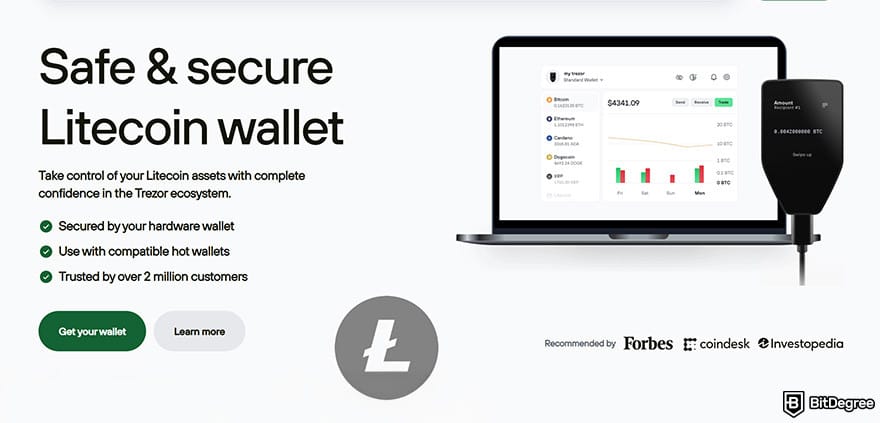
- Extra Physical Security With microSD. You can use the built-in slot to add microSD encryption, reducing risks from physical breaches.
- Color Touchscreen With Haptics. Safe 5 features a colorful display under Gorilla Glass with tactile feedback for clear, confident transaction confirmations.
- Customizable Backup Options. You have a choice of standard recovery or advanced SLIP39 multi-share backups for long-term LTC security.
While the Safe 5 delivers a premium experience, it does come at quite a high cost – $169. However, for those serious about safeguarding their Litecoin, the blend of security features, build quality, and usability can make it worth the investment.
3. Trezor Safe 3 - Budget-Friendly and Compact Cold Storage
Ranks #3 out of 8 Crypto Wallets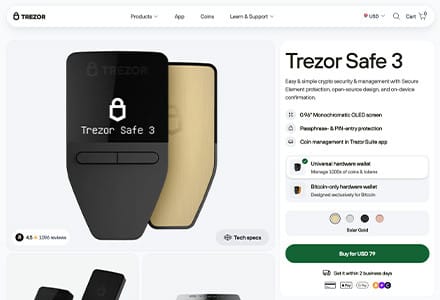
- + Resistant to brute-force attacks
- + Easy to set up
- + Crypto-industry pioneer
- + Supports 1,000+ digital assets
- + Open-source code
- + Affordable pricing
- - Potentially uncomfortable design
- - Plastic screen prone to scratches
If you’re after a secure yet no-frills hardware wallet for your Litecoin, Trezor Safe 3 makes a strong case. It’s built on Trezor’s legacy of open-source transparency but brings in a hardware upgrade with a Secure Element chip, which is something that wasn’t in older models.
The result? A sleek, affordable device that keeps your keys offline and verifiable, wrapped in a design that’s lean without feeling stripped down.

When you’re ready to move LTC, the Safe 3 pairs smoothly with Trezor Suite. You get clear prompts on a bright OLED screen and simple physical button confirmations.
It does everything you need: backups, PIN protection, passphrase support, and full token coverage, including reliable handling of Litecoin and its SegWit variants. Plus, it’s light enough to carry around, making it handy for both daily use and long-term storage.
Key Features
Here are some of the things people like most about Trezor Safe 3:
- EAL6+ Secure Element Chip. Unlike its predecessors, Safe 3 includes a dedicated Secure Element that stores your PIN and checks device authenticity.
- Monochrome OLED With Side Buttons. You can review Litecoin transactions clearly on the compact screen and confirm actions using tactile buttons. It may not be flashy, but it’s easy to use.
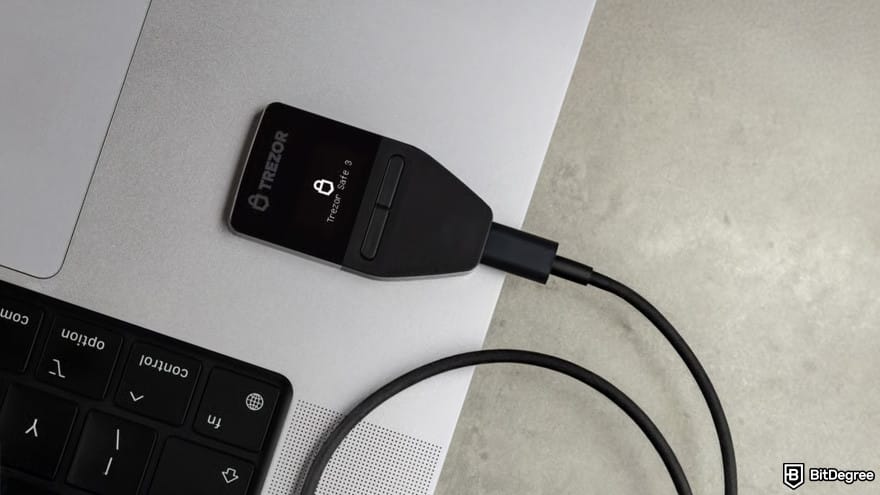
- Flexible Recovery With SLIP39 & Passphrase Support. Safe 3 allows you to choose simple backup methods like a 12/24-word seed or go advanced with Shamir-style SLIP39 multi-share recovery. Plus, you can add an optional passphrase for an extra layer of privacy.
- Wide Asset Support. You can manage Litecoin alongside thousands of other assets.
- Open-Source and Trustworthy. Just like every Trezor, the Safe 3’s firmware is open-source. That means your Litecoin’s safety can be audited by anyone.
As far as newer generation wallets are concerned, Trezor Safe 3 is a more budget-friendly option priced at $79. While it might not have all the bells and whistles, it gives you top-grade hardware security.

Did you know?
All Crypto wallets may look similar to you but they're NOT all the same!
4. Ledger Stax - Luxury-Level Cold Storage for Your Assets
Ranks #4 out of 8 Crypto Wallets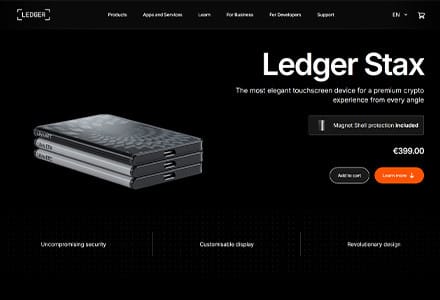
- + A brand-new design
- + Industry-leading security
- + Coin, token and NFT storage
- + High levels of customizability
- + Free Ledger Recovery Key included
- + Wireless charging
- - Pricey
$90 BTC BONUS
Ledger Holiday Season Sale
Grab Ledger Stax, Flex and Nano S Plus during this Holiday Season & get BTC vouchers worth up to $90! 2025 is almost over and so is the stock for this deal, hurry up!
Ledger Stax is Ledger’s boldest take on combining style, comfort, and serious crypto security. Designed by Tony Fadell, the man behind the iPod, it feels less like a tech gadget and more like a premium accessory.
The curved E-Ink display is the star here – it’s large enough to comfortably review full Litecoin transaction details, but it also doubles as a customizable canvas, letting you display your name, an NFT, or even a favorite graphic when idle.

Of course, it’s not all looks. The Stax runs on Ledger’s EAL6+ certified Secure Element chip with the BOLOS operating system, keeping your private keys offline and out of reach from both remote and physical attacks.
Magnetic edges let you stack multiple Stax devices together neatly, which is a dandy feature if you keep different wallets for long-term storage and daily transactions.
Key Features
There is more than one feature that make it a standout choice among the best Litecoin wallets:
- Curved 3.7-Inch E-Ink Display. A spacious screen designed for clarity, showing your entire Litecoin transaction in clear detail before you approve it.
- Direct Secure Element Display Control. The screen is wired directly into the security chip, meaning what you see is exactly what you sign.
- Wireless Charging & Cable-Free Connectivity. You can recharge Stax on a Qi pad and connect via Bluetooth to Ledger Live for easy LTC management without clutter.
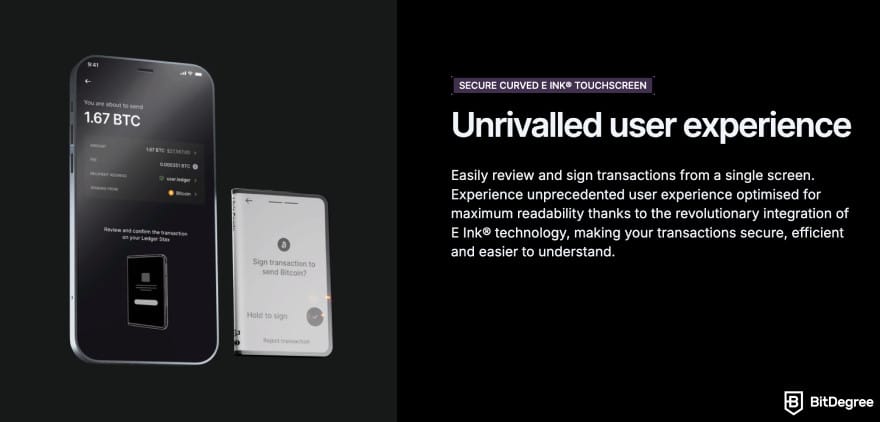
- Ledger Recovery Key Included. Stax comes with a secure backup solution so you can recover your Litecoin wallet if your device is lost or damaged.
- Broad Crypto & NFT Support. Alongside Litecoin, you can manage 5,500+ other coins and tokens, plus NFTs, directly from Ledger Live or supported third-party apps.
However, with a price tag of $399, it might not be for everyone. I'd say Ledger Stax is for Litecoin holders who value design, comfort, and the little quality-of-life features that make daily use smoother.
5. Binance Web3 Wallet - A Smooth Blend of Self-Custody and Convenience
Ranks #5 out of 8 Crypto Wallets
- + Semi-custodial meets next-gen MPC
- + Incredibly easy-to-use
- + Connectivity to various dApps
- + Access to token swapping through Bridge 2.0
- + Potential yields through staking
- - No browser extension
SECURE $600 BONUS
Binance Holiday Sale
Sign up on Binance and claim up to $600 in trading fee credit for completing simple tasks during this Binance Holiday Sale. Use our Binance referral code (49316610) to activate the offer!
Binance Web3 wallet (or simply Binance Wallet) is Binance’s dedicated self‑custody Web3 wallet, distinct from the standard custodial wallet used for exchange balances. It brings together next‑generation crypto security with the ease of managing everything from tokens to DeFi, all within the familiar Binance ecosystem.
This makes it a strong pick for Litecoin holders who want straightforward access without giving up control of their assets.
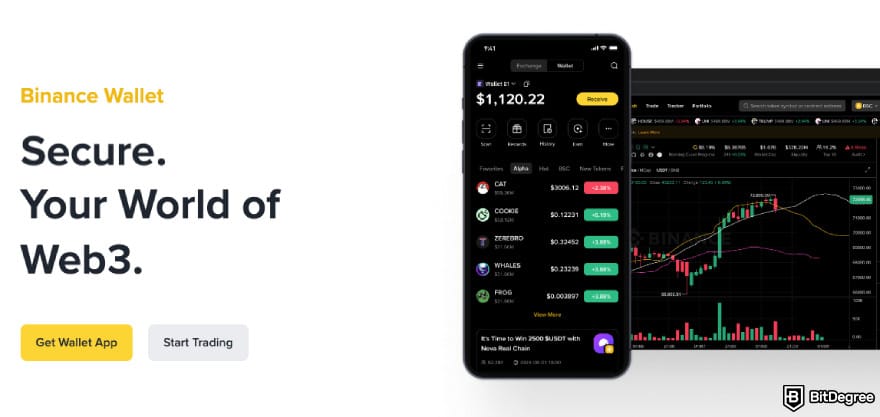
Binance Wallet utilizes multi-party computation (MPC) security technology, dividing your private key into three separate "shares" stored across your device, cloud storage, and Binance. This eliminates the need for a seed phrase. You need at least two key shares to access your wallet, greatly reducing the risk of compromise.
It comes built into the Binance app, so you can move funds seamlessly between your exchange account and your wallet, swap tokens, explore DeFi, and earn rewards.
Key Features
Let's take a look at some of the aspects that make Binance Wallet one of the best Litecoin software wallets:
- Built-In Swap Features & Cross-Chain Access. You can easily swap Litecoin and other tokens across different networks using Binance Bridge and DEXs, taking advantage of deep liquidity and competitive pricing.
- Web3 & DeFi Integration. Binance Wallet allows you to dive into DeFi, explore NFTs, or use decentralized apps, all within the Binance app’s Web3 interface.
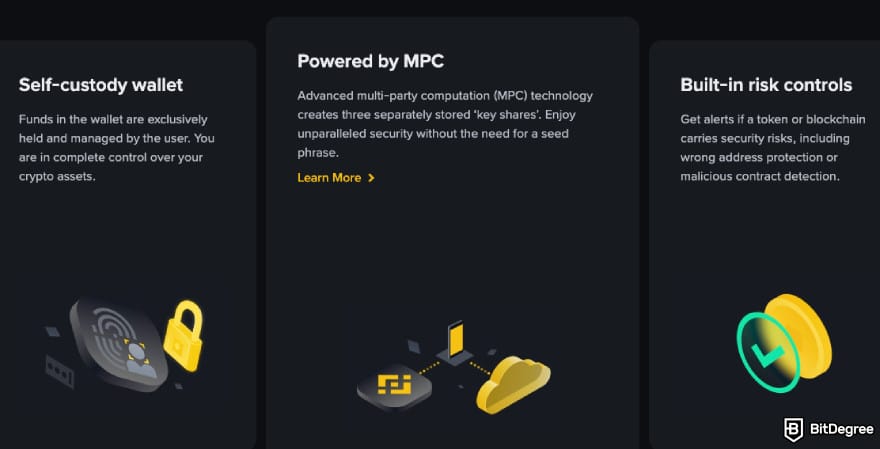
- Smart Risk Alerts. The wallet includes built-in security alerts like wrong-address detection and contract risk warnings, which will help you protect your Litecoin from accidental or malicious transactions.
- 24/7 Customer Support. As a Binance product, the wallet users benefit from continuous customer support, which is a rare luxury for self-custody wallets.
For Litecoin enthusiasts looking to manage LTC seamlessly while having solid protection and easy access to swaps and DeFi, this wallet is a compelling free choice, especially if you’re already part of the Binance ecosystem.
6. Coinbase Wallet - Web3 Wallet for Storing, Swaping, and Exploring Litecoin
Ranks #6 out of 8 Crypto Wallets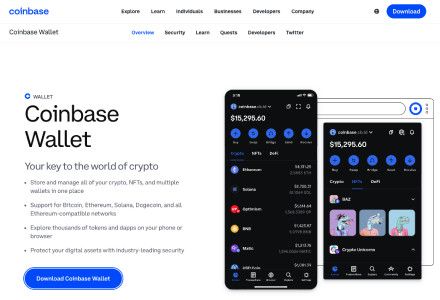
- + Easy to use
- + Free to register and keep crypto coins in
- + Supports thousands of digital assets
- + Top-notch security measures
- - Not as secure as a cold wallet
- - Not the best customer support
$2,000 IN CRYPTO
Celebrate With Coinbase
Score up to $2,000 in crypto this Holiday season – just sign up and make your first crypto purchase. Follow this Coinbase referral link to activate the deal!
Base App, formerly known as Coinbase Wallet, has grown into a powerful, all-in-one Web3 gateway. It became a platform for exploring DeFi, managing NFTs, chatting securely with other users, and swapping tokens directly from your wallet.
Base App is not the same as the Coinbase exchange built-in wallet – it's a separate non-custodial solution.
The rebrand to Base App reflects this broader scope, with a fresh interface and added features designed to make interacting with blockchain as simple as using your favorite mobile app.
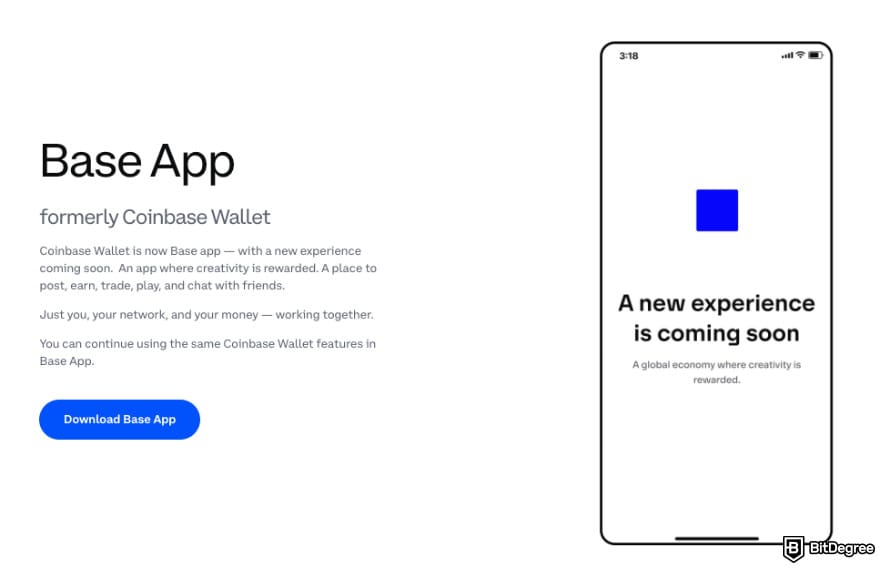
For Litecoin holders, Base App offers smooth, native LTC support alongside thousands of other assets. You can send and receive Litecoin, track its value, and store it securely in a non-custodial wallet where you hold the keys.
Key Features
Now, the features that make Base App a convenient Litecoin wallet include:
- Native Litecoin Support. You can easily send and receive LTC, including SegWit addresses for faster, cheaper transactions.
- Everything in One App. Beyond transactions, Base App allows you to access DeFi, mint NFTs, chat securely, and explore dApps from within the app.

- Flexible Backups. Encrypted cloud-based passkey backups make it easy to recover your wallet across devices.
- Global and User-Friendly. Base App is available in over 170 countries and 25 languages with a clean, intuitive interface.
- Secure, Self-Custody Model. You control your private keys, keeping your Litecoin and other assets truly yours.
Since Base App is a software wallet, you can download and use it for free, which makes it an especially convenient option.
7. Nexus Wallet - Everyday Mobile Wallet for Spending and Securing LTC
Ranks #7 out of 8 Crypto Wallets
- + Built for Litecoin
- + Flexa integration for everyday payments
- + Human-readable .ltc domains available
- + Supports in-app purchases
- - Mobile-only
- - Doesn't support other assets
Nexus Wallet is the official mobile wallet created by the Litecoin Foundation, available on Android and iOS.
For years, Litewallet served as the official mobile wallet, also developed by Litecoin Foundation. However, as technology and user needs evolved, the Foundation decided to shut down Litewallet by December 31, 2025 and replace it with a more modern, flexible solution.
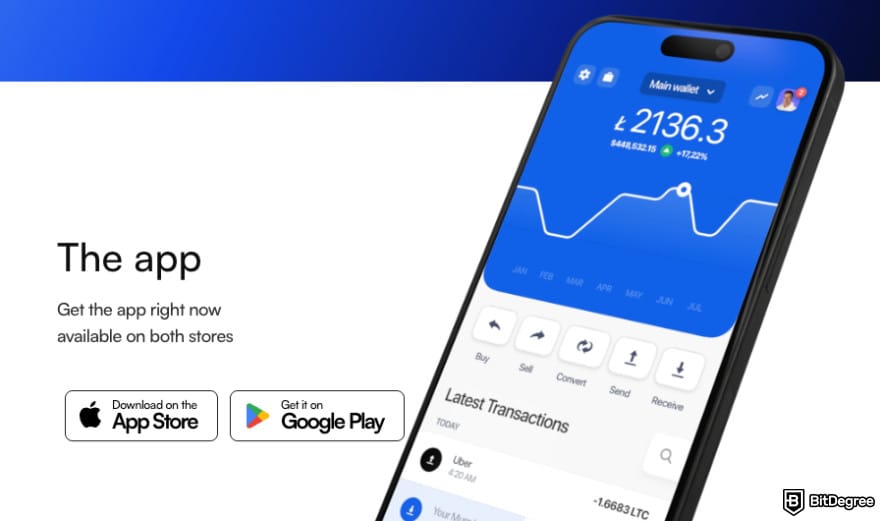
Nexus Wallet was created to take Litecoin’s mobile experience to the next level, offering improved security and better usability. Its aim is to make everyday Litecoin management and payments simpler, faster, and more in line with current industry standards, while keeping full control in the hands of the user.
Key Features
Here are the features that make Nexus one of the top Litecoin wallets:
- Native Litecoin & MWEB Support. Nexus supports both standard Litecoin transactions and MWEB (MimbleWimble Extension Blocks), giving you the choice between transparent and privacy-enhanced transfers.
- Flexa Payments Integration. This allows you to spend Litecoin at over 41,000 retail locations in North America like you would spend fiat currencies.
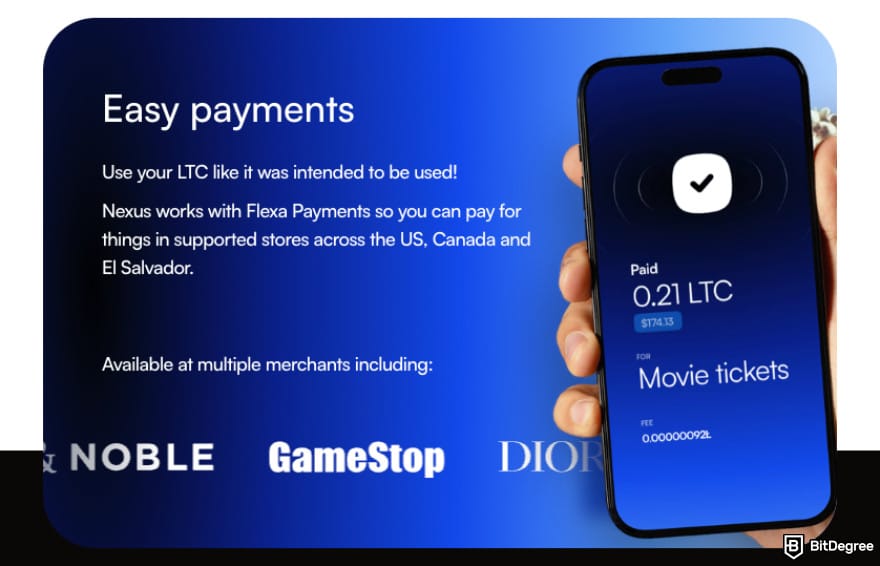
- .ltc Domain Addresses. You can easily create simple .ltc address to replace long wallet addresses with human-readable names.
- Built-In Price Alerts. Want to get notified when LTC hits your target price? Nexus allows you to set price alerts for that.
- In-App LTC Purchases. On the Nexus wallet, you can buy Litecoin with over 130 local payment methods.
All the dandy features aside, it does have a pretty big drawback for those who want to diversify their crypto portfolios – it only supports Litecoin. However, if that's not an issue for you, Nexus is the wallet created specifically for LTC users.
8. Exodus - An All-Rounder Software Wallet With Hardware Wallet Integration
Ranks #8 out of 8 Crypto Wallets
- + Easy to use
- + Has customer support
- + Multiple cryptocurrency choices
- + A software-based wallet
- + Built-in exchange features
- - Prone to security issues
- - The fees can reportedly be quite high
If you're looking for a powerful desktop, mobile or browser extension wallet to handle Litecoin and a variety of other assets, Exodus could be a good option.
Available on Windows, macOS, Linux, iOS, Android, Chrome, and Brave, this software wallet gives you complete control of your Litecoin through a clean, user-friendly interface.
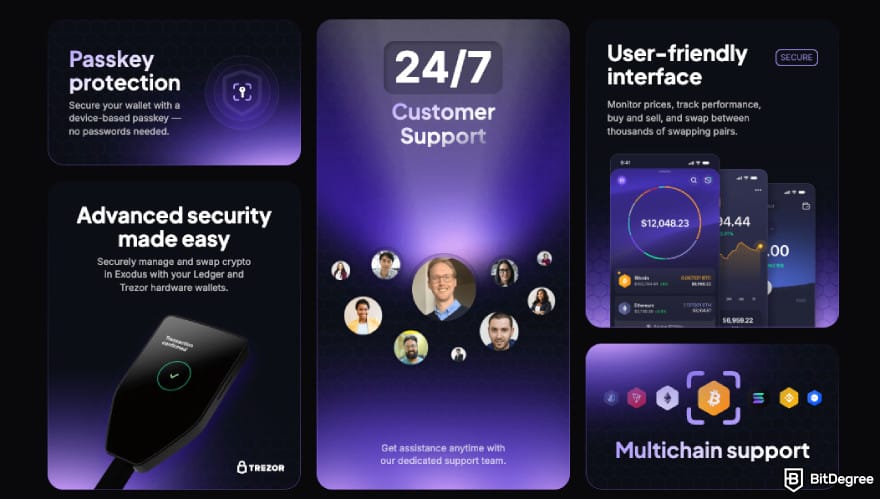
I'd say Exodus is a one-stop solution. You can send, receive, and swap Litecoin right inside the app, and even buy crypto using services like MoonPay or Ramp.
Plus, you get real-time portfolio tracking, staking options for select coins, and integration with Trezor and Ledger hardware wallets if you ever want to layer in cold storage (which you definitely should).
Key Features
The features that make Exodus a popular Litecoin wallet include:
- Native LTC Support with Easy Setup. You can send, receive, and view Litecoin transactions easily. The interface even uses QR codes to get you funded fast.
- In-App Swaps & Fiat On-Ramp. If you want to instantly exchange Litecoin for other assets without leaving the wallet, you can do that with Exodus thanks to integrated swap functionality and fiat purchase options.
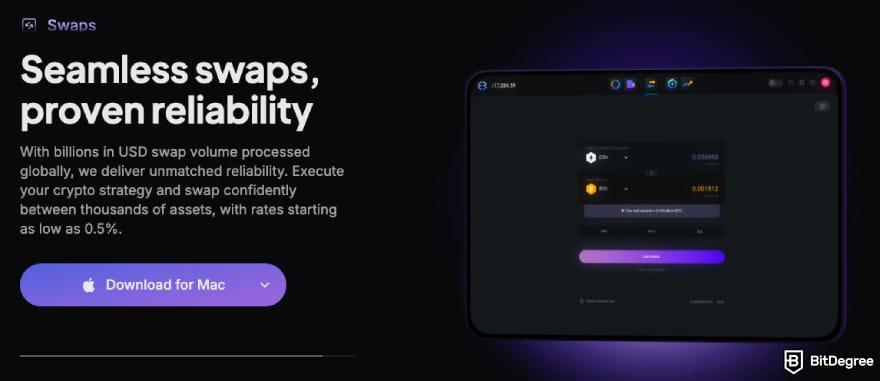
- Cross-Device Sync. Exodus can be used across desktop, mobile, and browser extension, keeping your LTC accessible wherever you go.
- Portfolio & Price Tools Built-In. You can track Litecoin’s performance in real time and set alerts to know the moment prices change.
Overall, Exodus is a free, feature-rich software wallet that supports Litecoin alongside an impressive lineup of other assets (over 1 million!).
Best Litecoin Wallet: Online Wallets
Now, as you can see from the options above, there are several types of wallets you can choose from to manage your LTC coins. If you're not sure about the difference, let's look into them in more detail.
Online wallets, also known as hot wallets, are ones that are always online (hence, the name). One of their biggest advantages is that they’re easy to access through the internet. However, that’s also their biggest disadvantage, because they’re more vulnerable to hacking.[1]
There are primarily three types of online wallets:
- Web-based wallet services accessed through your browser;
- Mobile software wallets for Android and iOS smartphones;
- Desktop software wallets, which you can download to your Windows, Mac or Linux computer.
FYI, there’s also the Litecoin Core wallet, which is the official full-node software maintained by the Litecoin project.

It offers maximum security and control by downloading and verifying the entire blockchain, but this comes at the cost of convenience – it requires significant storage space, a lengthy initial sync, and isn’t as user-friendly for quick or mobile transactions. For most everyday users, lighter wallets like mobile or desktop software wallets will be a better choice.
That said, let's find out more about each of the three main online Litecoin wallet types.
Some wallets could be classified as two or even all three types. For instance, the wallet built into Binance can be accessed via web, mobile app, and desktop app.
Web Wallets
A web wallet is a type of cryptocurrency wallet that a person can access through a web browser. Built-in wallets offered by exchanges like Binance or Coinbase can be considered web wallets. That said, they might be more vulnerable to hacking because they work on a centralized system.
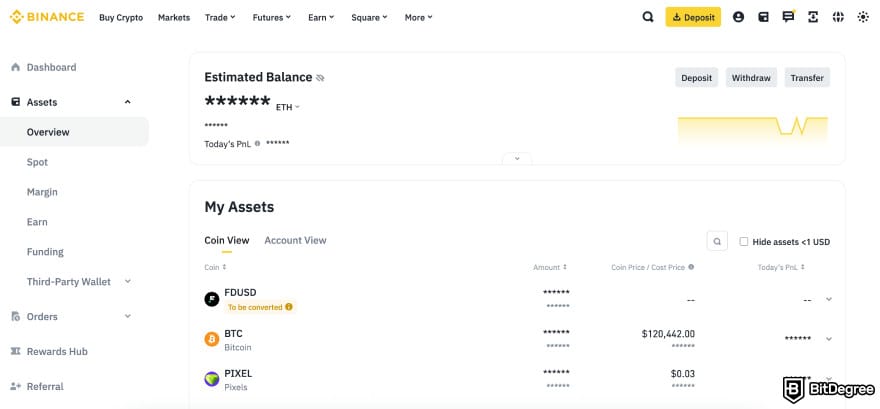
What this means is that the exchange in question has full control of your private keys. So, if that platform was hacked, the hackers could steal those keys, and with them, your funds. This takes the security out of your hands, which is never a good thing.
Advantages | Disadvantages |
|---|---|
✓ Easy to use and beginner-friendly | ✗ Vulnerable to online scams, attacks, and hacks |
✓ You can often buy or sell the top cryptocurrencies, including Litecoin, using fiat | ✗ You don’t control the private keys; your wallet lives on a third-party platform |
✓ You can manage multiple cryptocurrency transfers within a single account | ✗ You don’t technically “own” the wallet, so your assets are custodial |
✓ Can be accessed from anywhere with an internet connection | ✗ Such platforms usually don't consider such storing services a “wallet” in the traditional sense; they function primarily as a broker or an exchange |
Table: Advantages and disadvantages of web wallets
Just note that here I'm referring specifically to the built-in custodial wallets provided directly on exchange platforms (e.g., the default wallet in your Coinbase account). I'm not talking about any additional non-custodial wallet services or downloadable wallet apps that many exchanges also offer.
📚 Related: The Power of Crypto Self-Custody
Mobile Software Wallets
Mobile software wallets, like Zengo or Trust Wallet, are smartphone applications (Android and iOS) that sometimes also offer companion desktop/web-extension versions. They store your private keys locally on your device, giving you more direct control than a custodial web wallet, yet remain “hot” (i.e., online) and therefore subject to certain risks.

While there’s no shortage of mobile wallets for Bitcoin, dedicated Litecoin mobile wallets are fewer. You may sometimes need to enable Litecoin support manually or choose a multicoin wallet.
Nonetheless, such wallets usually can be customized so you can only show the coins and tokens that you have or want, keeping your interface uncluttered.
Advantages | Disadvantages |
|---|---|
✓ Mobile wallets usually have beginner-friendly interfaces designed for people with limited knowledge or understanding of crypto | ✗ It's still a "hot" wallet, so it stores your wallet keys on an "always-online" smartphone |
✓ Stores the private keys on the user's own handset, which makes it more difficult for hackers to steal their money (but not impossible) | ✗ Some apps might crash or lag during high-volume transactions |
✓ Many mobile wallets also provide browser extensions or desktop builds for seamless use across devices | ✗ Losing or breaking your phone without a proper backup strategy can permanently lock you out of your funds |
✓ Quick and easy to access |
Table: Advantages and disadvantages of mobile wallets
If you're using a mobile wallet, always make sure to update the app so you don't miss out on any important bug fixes or security improvements.
Desktop Software Wallets
Desktop software wallets, like Exodus, Electrum, or Atomic Wallet, are applications you install on your Windows, macOS, or Linux PC.
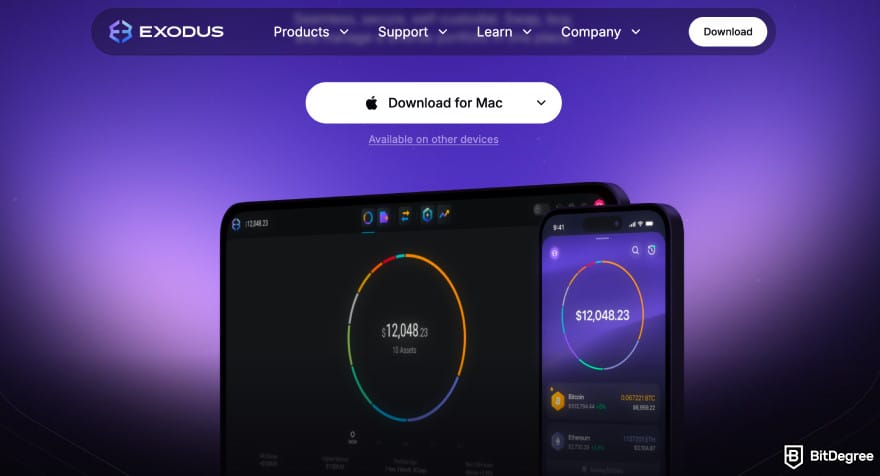
Like mobile wallets, they keep your private keys on your local device (rather than in the cloud) but remain “hot” so long as your computer is connected to the internet.
Advantages | Disadvantages |
|---|---|
✓ Usually have an easy-to-use interface | ✗ Being internet-connected still makes desktop wallets more vulnerable to malware or remote exploits than offline options |
✓ Higher level of security compared to web wallets | ✗ You must be wary of viruses on your computer and make sure you have antivirus software installed |
✓ Usually handle dozens of cryptocurrencies (including Litecoin) in one place | ✗ Some software wallets don’t let you customize network fees, which can mean higher costs during congestion |
✓ Often has recovery options, so your wallet is safe even if your PC gets stolen or breaks down | ✗ You can only send or receive funds from the computer where the wallet is installed (unless it offers a corresponding mobile or web interface) |
✓ Normally allows you to exchange cryptocurrencies with one another |
Table: Advantages and disadvantages of desktop software wallets
As you can see, online wallets offer ease-of-use and simplicity, but this comes at the ultimate cost – security. That said, let's explore offline wallets, including how they work and what are their advantages and disadvantages.
Best Litecoin Wallets: Offline Wallets
These types of wallets are physical wallets – they can usually be hardware-based or more traditionally paper-based (though there are some unconventional types, too, like sound wallets). They are also known as cold storage wallets because they are not always online like hot wallets.
Cold wallets offer the strongest security,[2] but it usually comes with a price tag (sometimes quite a hefty one). Not only that, some make it a bit more difficult to gain quick access to your crypto. So, if you want to day trade, they might not be the best option. Though, new generation hardware wallets offer companion apps to solve this issue.
Hardware Wallets
Hardware wallets like Ledger Flex or Trezor Safe 5 are standalone devices that store your private keys offline in a secure element. With such wallets, you sign transactions on-device, keeping your keys isolated even when connected to an internet-enabled computer or smartphone.
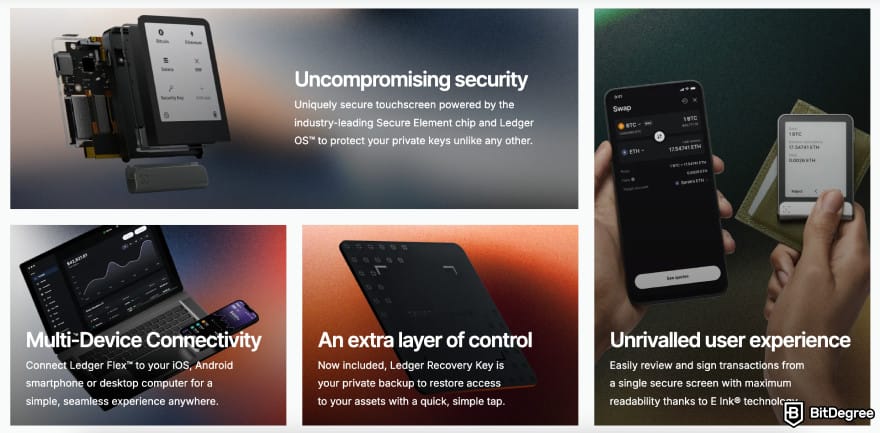
Because of this cold storage approach, hardware wallets are widely regarded as the most secure yet still reasonably convenient method for long-term cryptocurrency storage.
Advantages | Disadvantages |
|---|---|
✓ Private keys never leave the device, protecting them from malware, phishing attacks, or compromised host machines | ✗ Unlike free software wallets, hardware devices typically range from $50 – $400, which may scare away casual users |
✓ Most hardware wallets include a tamper-resistant chip and require a PIN to unlock transactions | ✗ Every transaction requires connecting the device, entering a PIN, and manually approving on a separate screen, which can be slower than clicking in a hot wallet |
✓ A built-in screen lets you confirm transaction details before signing, preventing man-in-the-middle attacks | ✗ While rare and quickly patched, hardware wallet firmware bugs have in the past exposed attack vectors (regular updates are essential!) |
✓ Recovery seed phrases allow you to restore your funds if the device is lost, damaged, or stolen | |
✓ Compact designs make them easy to carry and use across multiple computers or mobile devices |
Table: Advantages and disadvantages of hardware wallets
Overall, hardware wallets strike a strong balance between top-tier security and acceptable convenience, making them the go-to choice for users seeking to safeguard larger or long-term cryptocurrency holdings.
Paper Wallets
Paper wallets are probably the purest form of cold storage – you generate your public and private keys offline and then print them out on paper (or another physical medium).
Open-source services like LiteAddress.org allow you to create Litecoin paper wallets and then print your public and private keys on a piece of paper. It also provides a QR code that you can scan to access your wallet quicker.
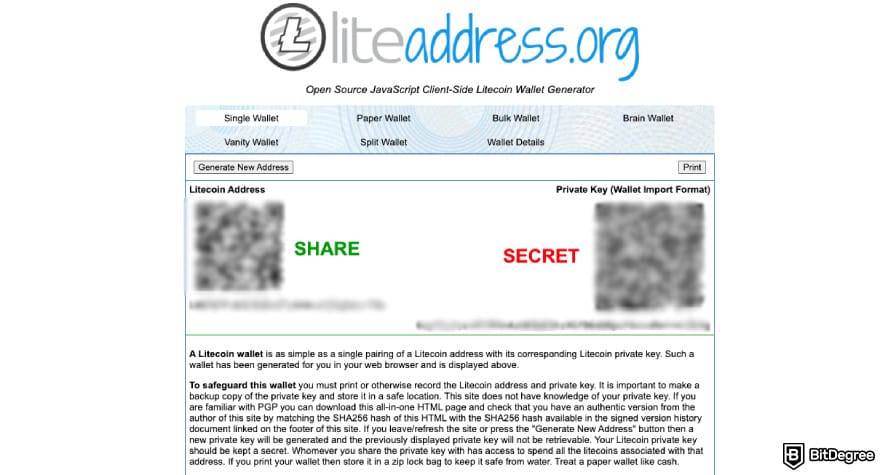
This type of wallet, while really safe, leaves you with the ultimate responsibility regarding your crypto security – if the document gets damaged, stolen or lost, you will lose access to your funds. That said, you must handle the paper itself with care, keeping it dry, fireproof, and out of prying eyes.
Advantages | Disadvantages |
|---|---|
✓ Easy to use, free, and can be set up within a minute | ✗ If the paper is damaged (water, fire, fading ink), lost, or stolen, your funds are irretrievable |
✓ Completely offline storage is hackproof – no one can hack your printed wallet keys | ✗ Generating the wallet on a compromised machine or printing without disconnecting from the internet can expose keys |
✓ Good for holding crypto over a long period of time | ✗ To access funds, you must import or sweep the paper wallet into a software or hardware wallet, which is inconvenient |
Table: Advantages and disadvantages of paper wallets
Summing things up, offline wallets are much safer than online wallets, but they still have some drawbacks. Paper wallets are good for long-term crypto asset storage, so if you buy Litecoin to hold it, then paper might work for you.
If you buy and sell crypto regularly, it would be best to invest in a hardware crypto wallet. They usually offer accompanying software apps that are convenient to use.
📚 Check Out: Best Hardware Wallets
Importance of Security
Many technological developments have made owning cryptocurrency safer, but security remains the top priority after choosing which crypto to invest in.
Because cryptocurrency is decentralized and largely unregulated, the responsibility for protecting your funds falls entirely on you – the investor. Decentralization can create a false sense of safety. While it may "feel" secure, that isn’t always the reality.
This is why you need a clear guide to help you choose the best Litecoin wallet for your specific needs.
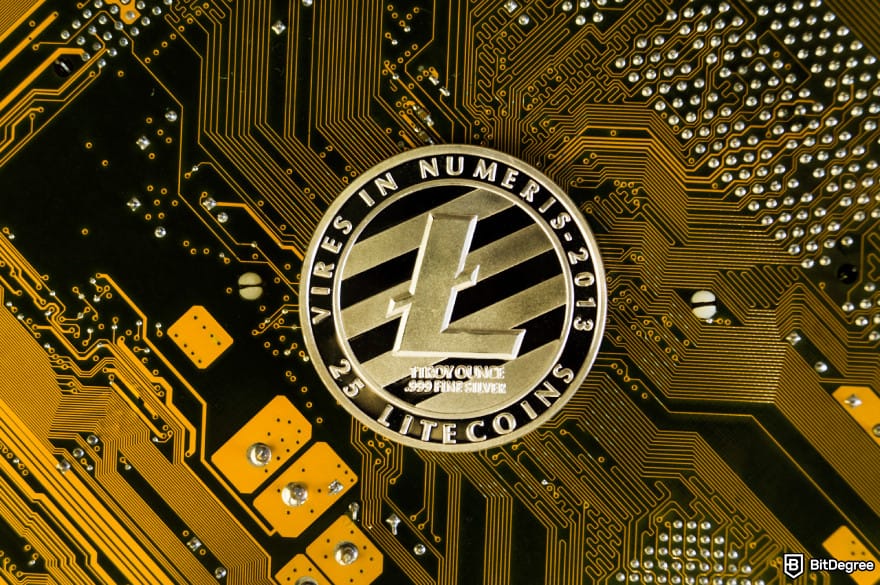
Keeping funds on an exchange leaves them vulnerable to hacks. This has happened many times – Mt. Gox and Coincheck are two major examples. Both were victims of significant cyberattacks: the Mt. Gox breach[3] led to bankruptcy, while the Coincheck hack[4] saw $530 million in cryptocurrency stolen.
Using a personal wallet helps protect your crypto by keeping your private keys in your control. Your public key (and wallet address) is used for receiving funds, while your private key is required to sign transactions and spend your crypto. As long as you keep your private key secure, you maintain full control over your assets.
📚 Read More: Crypto Wallet Security Guide
What is Litecoin?
A former Googler, Charlie Lee, created Litecoin in 2011. It was designed because Lee felt Bitcoin had "problems". Lee developed Litecoin to address some of Bitcoin's biggest issues, including transaction times, fees, and mining pool abuse.
Mining pool abuse refers to the risk of a single pool gaining too much mining power. Litecoin was created with a different hashing algorithm (Scrypt) to reduce the advantage of specialized mining hardware at the time.
Technically speaking, Litecoin is a peer-to-peer digital currency, just like Bitcoin, and can be used to make purchases online and even in some real-world stores. The advantages that it has over Bitcoin are that transaction times are faster and transaction costs are cheaper.

Litecoin’s block time is 2.5 minutes compared to Bitcoin’s 10 minutes, which allows faster confirmations. However, both networks can have fluctuating fees depending on demand.
At launch, Litecoin could be mined with regular CPUs and GPUs. However, over time, specialized ASIC miners for Scrypt have been developed, meaning mining is no longer easily done on basic computers.
📚 Read More: Bitcoin VS Litecoin
Conclusions
At this point, you should confidently know where to store Litecoin. Of course, every crypto investor is different, and everyone has different needs.
If you want quick access but with some built-in security, then Binance Wallet is a great working example. Also, if you trade in tiny amounts and want to do it from your smartphone, Base App (previously Coinbase Wallet) provides good security with speedy trading.
However, if you want to put security before transaction speeds, then you must go offline. If you want to invest in the long term, paper wallets can provide a good wallet-based approach to your cryptocurrency strategy. But you need to remember that paper isn’t the safest material available.
My conclusion is that hardware wallets like Ledger Flex or Trezor Safe 5 are the best and most secure way of storing Litecoin or any other crypto. They are safer than paper wallets because the material they are made of is much more resistant to damage.
So, you now know what the best Litecoin wallets are. Why not get out there and make your Litecoin cryptocurrency safer with hardware wallets? Protect your investments! You paid hard-earned cash for them, after all.
The content published on this website is not aimed to give any kind of financial, investment, trading, or any other form of advice. BitDegree.org does not endorse or suggest you to buy, sell or hold any kind of cryptocurrency. Before making financial investment decisions, do consult your financial advisor.
Scientific References
1. Mirza D., Rahulamathavan Y.: 'Security Analysis of Android Hot Cryptocurrency Wallet Applications';
2. Nowroozi E., Seyedshoari S., Mekdad Y., Savaş E., Conti M.: 'Cryptocurrency Wallets: Assessment and Security';
3. Steele S., Morishita T.: 'Chapter 24: Lessons from Mt Gox: practical considerations for a virtual currency insolvency';
4. Tsuchiya Y., Hiramoto N.: 'How cryptocurrency is laundered: Case study of Coincheck hacking incident'.











